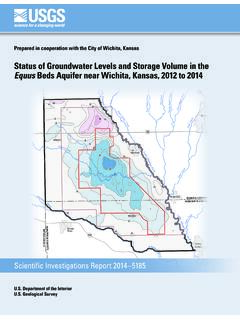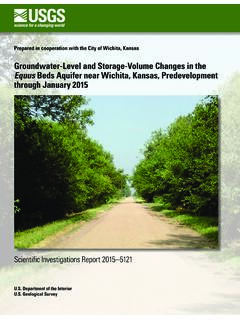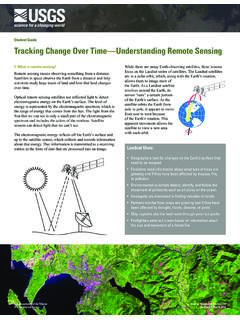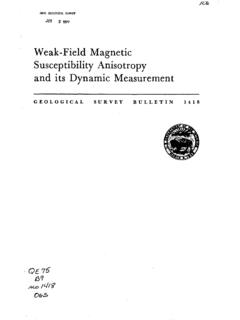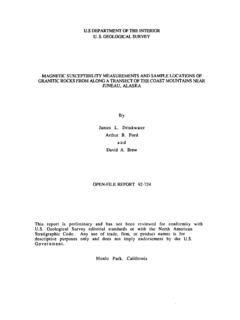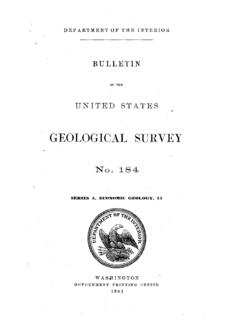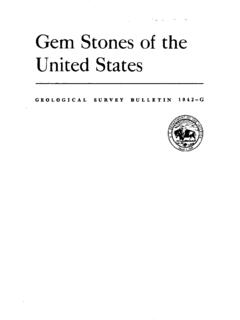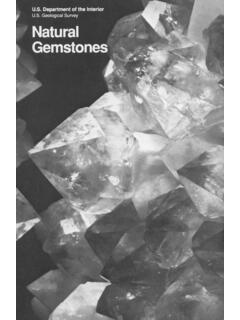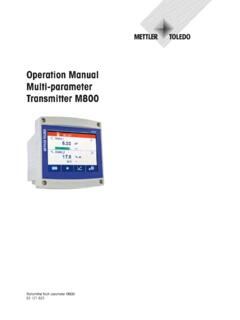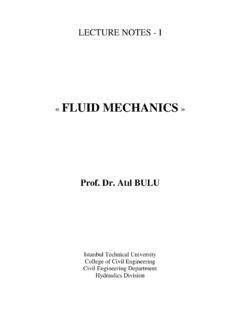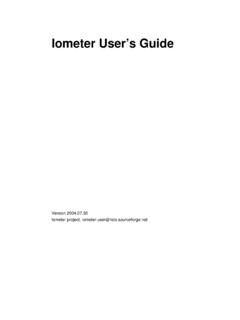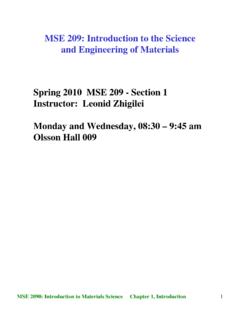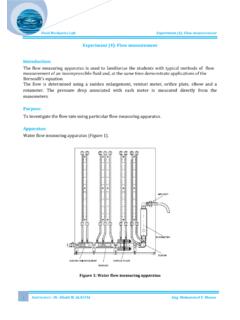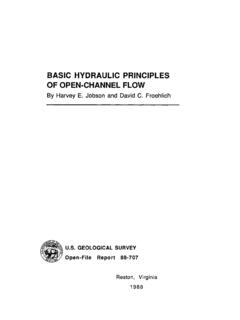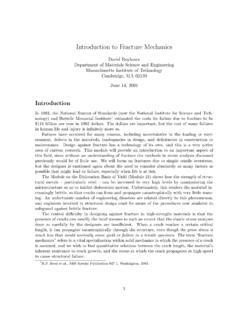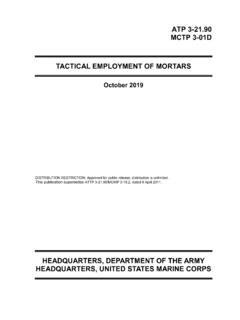Transcription of Basic Concepts of Kinematic-Wave Models - USGS
1 Basic Concepts of Kinematic-Wave ModelsU. S. GEOLOGICAL SURVEY PROFESSIONAL PAPER 1302 Basic Concepts of Kinematic-Wave Models #y JEFFREY E. MILLERU. S. GEOLOGICAL SURVEY PROFESSIONAL PAPER 1302 UNITED STATES GOVERNMENT PRINTING OFFICE, WASHINGTON: 1984 UNITED STATES DEPARTMENT OF THE INTERIOR WILLIAM P. CLARK, SecretaryGEOLOGICAL SURVEY Dallas L. Peck, DirectorLibrary of Congress Cataloging in Publication DataMiller, Jeffrey Concepts of kinetic-wave Models .(Geological Survey professional paper ; 1302)Bibliography: of Docs, no.: :13021. Water waves Mathematical Models . I. Series. 1983 627'.042 83-600251 For sale by the Distribution Branch, Geological Survey, 604 South Pickett Street, Alexandria, VA 22304 PREFACEK inematic-wave Models are used extensively by the Geological Survey. Both kinematic- and modified Kinematic-Wave Models are used for channel and overland-flow routing in the Precipitation-Runoff Modeling system and in the Distributed Routing Rainfall-Runoff Model.
2 The development of the theory and application of kinematic waves is complex, but it is not readily available in any one text. Therefore, the purpose of this report is to present the Basic con- cepts of the Kinematic-Wave approximation of one-dimensional dynamic waves . The report is intended for an audience of field hydrologists applying kinematic- wave Models in practical situations such as watershed Models . This report does not propose to assess or describe the current state of the art of approximate hydraulic-flow routing techniques. It is intended to be used as a Basic reference on the theory and application of Kinematic-Wave Models and modified Kinematic-Wave Kinematic-Wave model is one of a number of approximations of the dynamic-wave model. Because of the numerous approximations made in the development of the Models and the difficulty involved in applying the solution techniques, the Kinematic-Wave approximation needs to be understood in rela- tion to the other Models .
3 Therefore, a significant part of the report describes the dynamic-wave model, including a detailed development of the governing equations. This development is important because it shows the assumptions made in describing unsteady flow with the full dynamic-wave equations. These assumptions are inherent in any of the Models that are approximations of the dynamic-wave model, such as the Kinematic-Wave of the intended audience, the equation developments are given in detail so that they will be understood as easily as possible. There are many Basic Concepts involved in the application of Kinematic-Wave Models that can be confusing. Instead of assuming that these Concepts are obvious to the reader, they are included in a supplemental information introduction History of development of Kinematic-Wave theory- Development of governing equations Continuity equation Equation of motionDevelopment of Kinematic-Wave approximations Importance of assumptions and approximations -Kinematic waves Properties of kinematic waves Solution techniques -Finite-difference methods Method of characteristics Kinematic shock Dynamic versus kinematic waves - Approximations of dynamic waves - 1- 1- 1 _ 2-- 3- 4- 7- 7- 7- 8- 8- 9-10-12 Criteria describing limitations of applicability of approximations -Further limitations of applicability Special topics and applications Summary and conclusions References Supplemental informationEquation development Concepts Momentum versus energy Coordinate systems-18-20-23-23- 4-24-25 Friction-slope approximations 25 Methods for
4 Estimating a and m 26 Development of diffusion-analogy model 127 Development of step-backwater from dynamic-wave model 28 Kinematic-Wave model used in the distributed routing rainfall-runoff model 9 ILLUSTRATIONSFIGURE1. Definition sketch for the continuity equation 2. Longitudinal section showing prism and wedge storage 4. Water-surface profiles at time, t and t+At, showing distortion or steepening of the kinematic wave 5. Fixed crrid in the * t nlane ahnwinff Inmtirm nf crriH nninta and ivm-ritAm i and i Page 4 I 5 10. of x-t plane showing typical characteristic paths for the Kinematic-Wave equations, with and without lateral inflow-Water-surface profiles at time, t and t+At, and the characteristic paths between them showing the condition necessary for shock formation-412 Comparison of kinematic- and dynamic-wave model results showing the upstream hydrograph and predicted hydrographsat 20,000,40,000,60,000, and 80,000 feet 19 Four-point finite-difference grid 2210.
5 Use of log-log plot of discharge, Q, and flow area, A, to define the routing parameters, a and m VICONTENTSTABLETABLE 1. RELATIONS FOR ESTIMATING a and m based on physical characteristics of channel segments --27 SELECTED FACTORS FOR CONVERTING INCH-POUND UNITS TO THE INTERNATIONAL SYSTEM OF UNITS (SDFor those readers who may prefer to use the International System of units (SD rather than inch- pound units, the conversion factors for the terms used in this report are given inch-pound unitCubic foot per secondFootFoot per mileFoot per obtain SI unitcubic meter per secondmetermeter per kilometermeter per secondDEFINITION OF SYMBOLSa acceleration or coefficient in the wetted perimeter-flow area relationship,A cross-sectional flow area,Af area of flow at pipe-full conditions,b coefficient in the wetted perimeter flow-area relationship,B water-surface width,c wave celerity,C Chezy friction coefficient or Courant number,f force,F Froude number = u/Vg y,F0 Froude number for normal flow = v0/^jg~y tg gravitational acceleration.))
6 H height of water surface above datum or piezometric head,hf friction loss,H total energy head,i finite-difference grid location in the ^-direction,j finite-difference grid location in the time direction,K kinematic-flow number,L length of wave,L0 length of channel segment or overland-flow plane,m mass or coefficient in the steady uniform flow equation approximation,n Manning's roughness coefficient,P wetted perimeter,Pc channel parameter,rea>,I,q di la10Q di Q, di*ff h:Sa a<Se eiS^- fr S0 b < tiT wu flU0 StWt tiWx sFX h(y v(% n<2 h(a cc tiy sp0 ai p diC d< TO mdischarge per unit width (can be either flow in a channel or lateral inflow), discharge,discharge at pipe-full conditions, hydraulic radius = A/P, acceleration slope, energy slope = -dH/dx, friction slope, bed slope = -dz/dx, time,wave period, flow velocity,steady-state normal flow velocity, time derivative weighting factor, spacial derivative weighting factor, horizontal distance, vertical stream depth, normal depth,height of stream bottom above datum, coefficient in the steady uniform flow equation approxima- tion,specific weight of water, angle of the channel bed with the horizontal, diffusion coefficient, density of fluid, and mean longitudinal shear Concepts OF Kinematic-Wave MODELSBy JEFFREY E.)))
7 MILLERABSTRACTThe Kinematic-Wave model is one of a number of approximations of the dynamic-wave model. The dynamic-wave model describes one- dimensional shallow-water waves (unsteady, gradually varied, open- channel flow). This report provides a Basic reference on the theory and applications of the Kinematic-Wave model and describes the limi- tations of the model in relation to the other approximations of the dynamic-wave model. In the Kinematic-Wave approximation, a num- ber of the terms in the equation of motion are assumed to be insignif- icant. The equation of motion is replaced by an equation describing uniform flow. Thus, the Kinematic-Wave model is described by the continuity equation and a uniform-flow equation such as the well- known Chezy or Manning formulas. Kinematic-Wave Models are applicable to overland flow where lateral inflow is continuously added and is a large part of the total flow. For channel-routing applications, the Kinematic-Wave model always predicts a steeper wave with less dispersion and attenuation than actually occurs.
8 The effect of the accumulation of errors in the Kinematic-Wave model shows that the approximations made in the development of the Kinematic-Wave equations are not generally justified for most channel-routing applications. Modified flow-routing Models can be used which help to stop the accumulation of errors that occur when the Kinematic-Wave model is Kinematic-Wave model is one of a number of ap- proximations of the dynamic-wave model. The dynamic- wave model describes one-dimensional shallow-water waves (unsteady, gradually varied, open-channel flow) and consists of the continuity equation and the equa- tion of motion with appropriately prescribed initial and boundary conditions. In most approximations of dynamic waves , the continuity equation and an approx- imation of the equation of motion are solved. In the Kinematic-Wave approximation, a number of the terms in the equation of motion are assumed to be insignifi- cant; therefore, the equation of motion simply states that the friction slope is equal to the bed slope.
9 It is replaced by an equation describing uniform (which also implies steady) flow. Thus, the Kinematic-Wave model is described by the continuity equation and a uniform- flow equation, such as the well-known Chezy or Mann- ing formulas, plus the usually imposed initial and boundary theory describes a distinctive type of wave motion that can occur in many one-dimen- sional flow problems (Lighthill and Whitham, 1955, p. 281). The theory is described in this report as an approximation of dynamic-wave theory applied to water-routing purpose of this report is to provide a Basic refer- ence on the theory and applications of the kinematic- wave model and to describe the limitations of the model in relation to the dynamic-wave model. The Kinematic-Wave model is also described in relation to the other hydraulic-routing techniques that are ap- proximations of the dynamic-wave model. Unless specifically indicated, the channels described in this report are prismatic, and most of the explanations of the behavior of the Models will use examples that in- clude no lateral inflow.
10 These simplifications make the behavior of the Models easier to illustrate because changes in numerically routed hydrographs are not masked by other influences. The development, assump- tions and approximations, properties, criteria for application, current applications, and solution tech- niques of Kinematic-Wave theory in water routing will be OF DEVELOPMENT OF Kinematic-Wave THEORYThe development of Kinematic-Wave theory occurred late in the history of the development of the theory of open-channel flow. It is based on the early develop- ments in the study of steady varied flow and the later developments in the study of unsteady to Bakhmeteff (1932, p. 299), the theory of steady varied flow is usually associated with J. M. Belanger. Bakhmeteff stated that Belanger, in his 1828 paper, covers the "subject of varied flow in a remarkably complete and comprehensive manner." Bakhmeteff listed earlier references on varied flow, such as Dubuat in 1779, Venturoli in 1818, and par- ticularly Massetti in 1827.
